MATERIALS HANDLING & CONVEYING TECHNOLOGY & PRODUCTS
Raw Materials Handling
Raw materials handling equipment and systems play a crucial role in processing industries by efficiently and safely transporting, storing, and managing raw materials or bulk solids. These systems ensure the uninterrupted flow of materials from their source to various processing stages. Here’s a detailed overview of raw materials handling equipment and systems, including their working principles, advantages, disadvantages, applications, materials of construction (MOC), and a summary: |
| Working Principles: |
| Raw materials handling equipment and systems encompass a variety of machinery and methods. Here are some common types and their working principles: |
| Conveyor Systems: Conveyor belts, chains, or rollers are used to transport materials horizontally, vertically, or on inclines. The conveyor moves materials from one point to another through mechanical motion. |
| Pneumatic Conveyors: These systems use air pressure to convey bulk materials through pipelines. They can operate in either dense-phase or dilute-phase modes, depending on material properties and desired conveying speed. |
| Bucket Elevators: These machines use buckets attached to a rotating chain or belt to lift materials vertically. Materials are scooped into the buckets at the bottom and discharged at the top. |
| Screw Conveyors: A rotating screw inside a trough or tube moves materials along its length. The helical shape of the screw propels materials forward as the screw rotates. |
| Vibratory Feeders: Vibrating mechanisms or feeders move materials in a controlled manner, often using electromagnetic or mechanical vibrations. |
| Hoppers and Bins: These storage containers hold bulk materials until they are needed in the processing system. They can include various discharge mechanisms such as gates, chutes, or feeders. |
| Advantages: |
| Efficiency: Raw materials handling systems automate material transport, reducing manual labor and improving overall process efficiency. |
| Consistency: Automated systems ensure a consistent and controlled flow of materials, reducing variations in processing. |
| Safety: Properly designed and maintained equipment reduces the risk of accidents associated with manual handling of heavy or hazardous materials. |
| Reduced Contamination: Closed systems like pneumatic conveyors can help maintain material integrity and reduce the risk of contamination. |
| Disadvantages: |
| Initial Cost: The purchase, installation, and integration of raw materials handling equipment can involve significant upfront costs. |
| Maintenance: Regular maintenance is essential to ensure the safe and efficient operation of handling systems. |
| Space Requirements: Conveyor systems and large storage bins can require substantial floor space, impacting facility layout. |
| Energy Consumption: Powered systems, like conveyor belts, consume energy, and operational costs can be significant. |
| Applications: |
| Raw materials handling equipment and systems find applications across various industries, including: |
| Agriculture: For handling and transporting grains, seeds, and feed. |
| Mining and Minerals: To transport ores, coal, and minerals within mining facilities. |
| Food Processing: For moving ingredients and products within food processing plants. |
| Chemical Industry: To handle bulk chemicals and raw materials for production. |
| Manufacturing: For conveying materials between different stages of production. |
| Construction: To transport aggregates, cement, and other construction materials. |
| Pharmaceuticals: For transporting bulk pharmaceutical ingredients (APIs) within manufacturing facilities. |
| Materials of Construction (MOC): |
| The choice of materials for raw materials handling equipment depends on factors such as the type of material being handled, environmental conditions, and hygiene requirements. Common materials of construction include: |
| Stainless Steel: Suitable for industries requiring corrosion resistance, such as food, pharmaceuticals, and chemicals. |
| Carbon Steel: Commonly used for non-food industrial applications where corrosion resistance is not a primary concern. |
| Plastics: Used for conveyor components, hoppers, and chutes when chemical resistance and low weight are required. |
| Summary: |
| Raw materials handling equipment and systems are essential in processing industries for efficient and safe material transport, storage, and management. These systems, ranging from conveyor belts to pneumatic conveyors and storage bins, offer advantages like increased efficiency, reduced manual labor, and improved safety. However, they also come with considerations such as initial cost, maintenance requirements, space utilization, and energy consumption. The choice of equipment and materials of construction depends on specific industry requirements and applications. |
A. Jumbo Bag Unloading
| A Jumbo Bag Unloading System, also known as a Big Bag Discharging System or Bulk Bag Unloader, is an industrial equipment used for the efficient and controlled unloading of large, flexible intermediate bulk containers (FIBCs), commonly referred to as jumbo bags or bulk bags. These systems are widely used in various industries to transfer, discharge, and manage the contents of bulk bags. Here’s a detailed overview of Jumbo Bag Unloading Systems, including their working principles, advantages, disadvantages, applications, materials of construction (MOC), and a summary: |
| Working Principles: |
| The working principle of a Jumbo Bag Unloading System involves the following steps: |
| Bag Suspension: The filled jumbo bag is typically suspended from a frame or hoist within the unloading system. The bag is secured in a way that allows it to be safely and precisely positioned above the unloading station. |
| Bag Untying or Cutting: Depending on the design of the system, the bag’s closure, typically a tie or a flap, is either untied manually or cut using a mechanical or automated mechanism. |
| Discharge into Hopper: The contents of the jumbo bag flow under the influence of gravity through a discharge spout or chute into a receiving hopper or container. |
| Flow Control: Many Jumbo Bag Unloading Systems are equipped with features like flow control devices, vibrators, or agitators to ensure consistent and controlled material discharge from the bag. |
| Material Transfer: After discharging into the hopper, the material can be further transported through a conveying system to its destination, such as a processing unit, storage silo, or packaging line. |
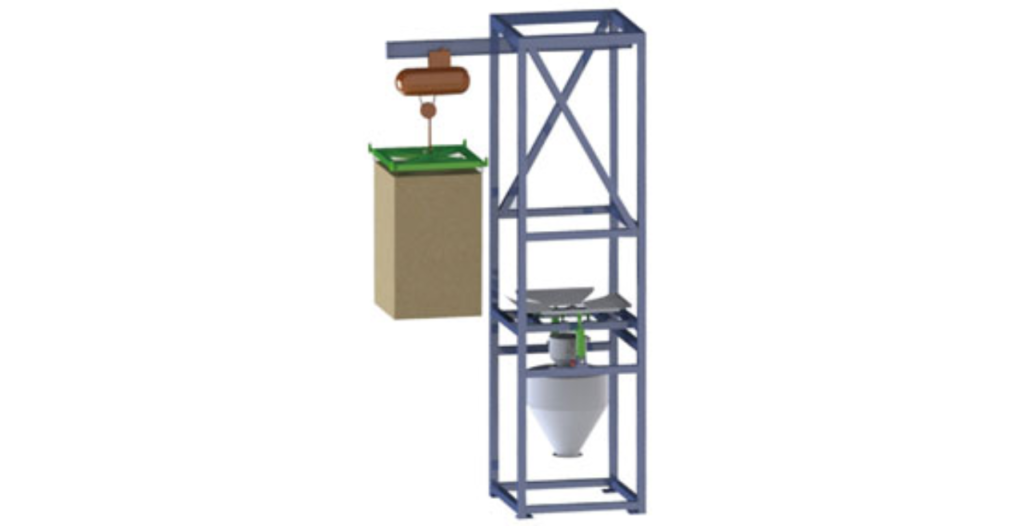
| Advantages: |
| Efficient Unloading: These systems ensure efficient and controlled unloading of bulk materials from jumbo bags, minimizing waste and spillage. |
| Safety: Jumbo Bag Unloading Systems are designed to improve workplace safety by automating the unloading process, reducing manual handling of heavy bags. |
| Dust Control: Many systems include dust collection or containment features to prevent the release of airborne particles during unloading, enhancing worker safety and environmental compliance. |
| Versatility: They can handle a wide range of bulk materials, including powders, granules, and aggregates. |
| Reduced Labor: Automation reduces the need for manual labor in unloading operations. |
| Disadvantages: |
| Initial Investment: Jumbo Bag Unloading Systems can have a relatively high upfront cost, depending on the complexity and automation level. |
| Maintenance: Regular maintenance is required to ensure proper functioning, including cleaning of the equipment to prevent cross-contamination. |
| Space Requirements: These systems can take up a significant amount of floor space, which may impact facility layout. |
| Compatibility: Compatibility with specific bag sizes and types may vary depending on the design of the system. |

| Applications: |
| Jumbo Bag Unloading Systems are used in various industries, including: |
| Chemical Industry: For unloading and handling bulk chemicals and powders. |
| Food Industry: In the handling of ingredients like flour, sugar, and spices. |
| Pharmaceuticals: For unloading and transferring pharmaceutical powders and ingredients. |
| Agriculture: In the handling of fertilizers, seeds, and agricultural bulk materials. |
| Mining and Minerals: For the unloading of minerals and ores from jumbo bags. |
| Construction: In the handling of cement, sand, and construction materials. |
| Materials of Construction (MOC): |
| The choice of materials for Jumbo Bag Unloading Systems depends on factors such as the type of material being handled, hygiene requirements, and corrosion resistance. Common materials of construction include: |
| Stainless Steel: Suitable for industries requiring corrosion resistance and hygiene, such as food and pharmaceuticals. |
| Carbon Steel: Commonly used in non-food industrial applications where corrosion resistance is not a primary concern. |
| Plastics or Coatings: Used for certain components to prevent material contamination and corrosion. |
| Summary: |
| A Jumbo Bag Unloading System is an essential industrial equipment used for efficient and controlled unloading of bulk materials from large flexible intermediate bulk containers (FIBCs). These systems provide advantages such as efficient unloading, enhanced safety, dust control, and versatility in handling various bulk materials. However, they also come with considerations like initial investment, maintenance requirements, and space utilization. The choice of equipment and materials of construction depends on specific industry requirements and applications. |
B. Manual Bag Dump Station (BDS)
| A Manual Bag Dump Station, also known as a Bag Dump Hopper or Bag Unloading Station, is an industrial equipment designed for the safe and efficient emptying of bags containing bulk materials. These stations are commonly used in various industries to handle powders, granules, and other bulk solids that are packaged in bags. Here’s a detailed overview of Manual Bag Dump Stations, including their working principles, advantages, disadvantages, applications, materials of construction (MOC), and a summary: |
| Working Principles: |
| The working principle of a Manual Bag Dump Station involves the following steps: |
| Bag Placement: An operator places the bag to be emptied on the bag dump station’s work surface, which is typically a perforated or grated platform. |
| Bag Opening: The operator opens the bag using manual methods, such as cutting or untying the bag’s closure mechanism. |
| Material Discharge: The contents of the bag, which can be powders, granules, or other bulk materials, flow out under the influence of gravity through the perforations or grates on the work surface. |
| Dust Control: Many Manual Bag Dump Stations are equipped with dust control measures, such as dust collection systems or containment enclosures, to capture and control airborne dust generated during bag emptying. |
| Material Collection: The discharged material is collected in a hopper or container below the work surface, from where it can be further processed or conveyed to the desired destination. |
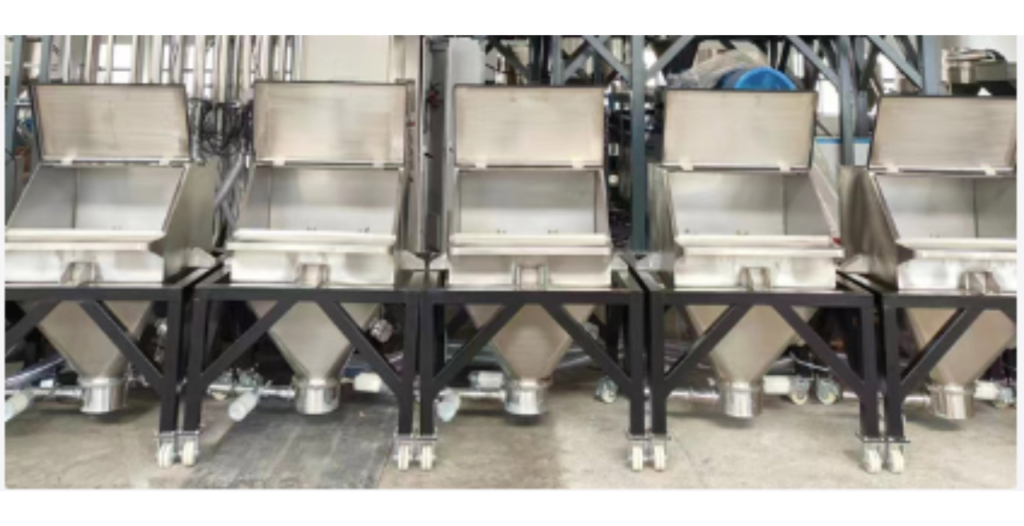
| Applications: |
| Manual Bag Dump Stations are used in various industries, including: |
| Food Industry: For handling ingredients like flour, sugar, and spices. |
| Pharmaceuticals: In the handling of pharmaceutical powders and ingredients. |
| Chemical Industry: For handling bulk chemicals and powders. |
| Agriculture: In the handling of fertilizers, seeds, and agricultural bulk materials. |
| Construction: For handling cement, sand, and construction materials. |
| Mining and Minerals: In the handling of minerals, ores, and aggregates. |

| Materials of Construction (MOC): |
| The choice of materials for Manual Bag Dump Stations depends on factors such as the type of material being handled, hygiene requirements, and corrosion resistance. Common materials of construction include: |
| Stainless Steel: Suitable for industries requiring corrosion resistance and hygiene, such as food and pharmaceuticals. |
| Carbon Steel: Commonly used in non-food industrial applications where corrosion resistance is not a primary concern. |
| Plastics or Coatings: Used for certain components to prevent material contamination and corrosion. |
| Summary: |
| A Manual Bag Dump Station is an industrial equipment used for the safe and efficient emptying of bags containing bulk materials. These stations provide advantages such as worker safety, dust control, versatility, and low operating costs. However, they rely on manual labor and have space requirements. The choice of equipment and materials of construction depends on specific industry requirements and applications. |
C. Drum Lifter And Tilter Systems
| Drum Lifter and Tilter Systems are industrial equipment designed to safely handle and manipulate drums, barrels, or containers of various sizes and materials. These systems are widely used in industries such as chemical processing, pharmaceuticals, food and beverage, and manufacturing to efficiently lift, move, and tilt drums for various processes and applications. Here’s a detailed overview of Drum Lifter and Tilter Systems, including their working principles, advantages, disadvantages, applications, materials of construction (MOC), and a summary: |
| Working Principles: |
| The working principles of Drum Lifter and Tilter Systems involve mechanical or hydraulic mechanisms to lift, move, and tilt drums. These systems typically include the following components: |
| Lifting Mechanism: Drum lifters are equipped with a lifting mechanism, such as a clamp, fork, or cradle, designed to securely grip and lift the drum from its top or side. |
| Tilting Mechanism: Drum tilters are equipped with a tilting mechanism that allows the operator to control the angle at which the drum is tilted. This can be done manually or with the assistance of hydraulic or pneumatic systems. |
| Base and Frame: The system is mounted on a sturdy base or frame that provides stability and support during lifting and tilting operations. |
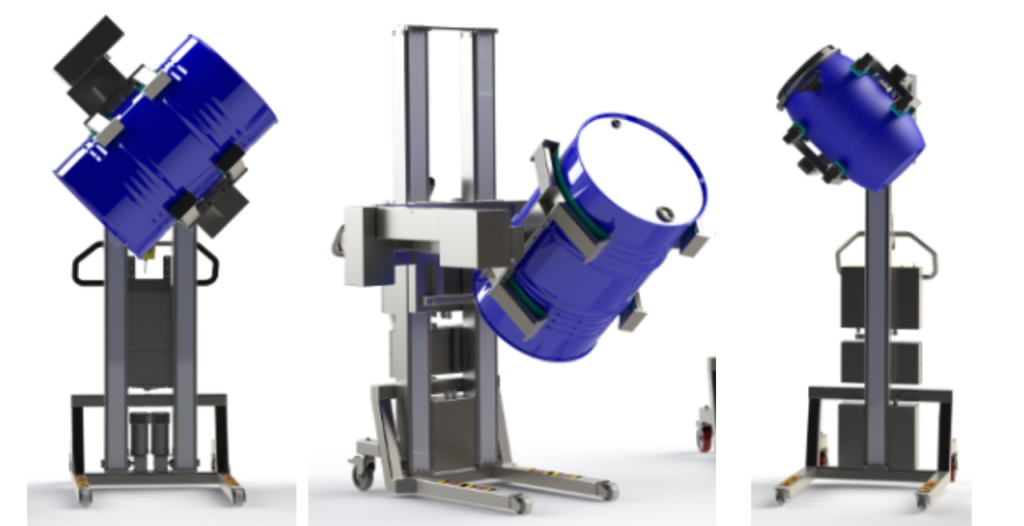
| Advantages: |
| Improved Safety: Drum Lifter and Tilter Systems are designed to enhance workplace safety by reducing the need for manual lifting and handling, which can lead to injuries. |
| Efficiency: These systems enable efficient handling and positioning of drums, increasing productivity and reducing labor costs. |
| Precision Control: Many systems offer precise control over the tilting angle, allowing for accurate pouring or dispensing of drum contents. |
| Versatility: They can handle drums of various sizes, materials, and shapes, making them suitable for a wide range of applications. |
| Reduced Spillage: Controlled drum tilting reduces the risk of spillage and product wastage. |
| Disadvantages: |
| Cost: Drum Lifter and Tilter Systems can have a significant upfront cost, which may be a drawback for some smaller businesses. |
| Maintenance: Regular maintenance is required to ensure the safe and efficient operation of these systems. |
| Space Requirements: They may require dedicated space in the facility for operation and storage. |
| Applications: |
| Drum Lifter and Tilter Systems are used in various industries and applications, including: |
| Chemical Processing: For transferring and dispensing chemicals from drums. |
| Pharmaceuticals: Handling and pouring pharmaceutical ingredients. |
| Food and Beverage: Managing ingredients, oils, and liquids in food processing. |
| Manufacturing: Positioning drums for production processes. |
| Waste Management: Emptying and handling drums containing hazardous waste. |
| Transport and Storage: Loading and unloading drums onto storage racks or containers. |
| Materials of Construction (MOC): |
| The choice of materials for Drum Lifter and Tilter Systems depends on factors such as the type of materials being handled and environmental conditions. Common materials of construction include: |
| Stainless Steel: Suitable for applications requiring corrosion resistance and hygiene, such as food and pharmaceuticals. |
| Carbon Steel: Used in non-food industrial applications where corrosion resistance is not a primary concern. |
| Aluminum: Offers a lightweight option with good corrosion resistance for certain applications. |
| Coatings: Components may be coated with materials like epoxy for added protection against corrosion. |
| Summary: |
| Drum Lifter and Tilter Systems are essential industrial equipment used for safely handling and manipulating drums and barrels in various industries. These systems enhance workplace safety, improve efficiency, and offer precise control over drum positioning. However, they come with considerations like initial cost, maintenance requirements, and space utilization. The choice of equipment and materials of construction depends on specific industry requirements and applications, ensuring the safe and efficient handling of drums. |
D. Automatic Bag Emptying Machine
| An Automatic Bag Emptying Machine is an industrial equipment designed to efficiently and automatically empty bulk bags, also known as FIBCs (Flexible Intermediate Bulk Containers) or super sacks, containing various powdered or granulated materials. These machines are commonly used in industries like food processing, chemicals, pharmaceuticals, and construction materials to automate the unloading of bulk materials from bags. Here’s a detailed overview of Automatic Bag Emptying Machines, including their working principles, advantages, disadvantages, applications, materials of construction (MOC), and a summary: |
| Working Principles: |
| The working principles of an Automatic Bag Emptying Machine typically involve the following steps: |
| Bag Placement: The filled bulk bag is placed onto a loading frame or platform designed to securely hold the bag during unloading. |
| Bag Cutting or Untying: Depending on the design of the machine, it may employ mechanisms for cutting or untying the bag’s closure, allowing access to the contents. |
| Material Discharge: The contents of the bag flow out through a discharge chute, funnel, or conveyor under the influence of gravity. |
| Material Handling: The discharged material is often conveyed to downstream processing equipment, storage vessels, or packaging systems. |
| Dust Control: Many Automatic Bag Emptying Machines include dust collection systems to capture airborne dust particles generated during bag emptying, enhancing worker safety and environmental compliance. |
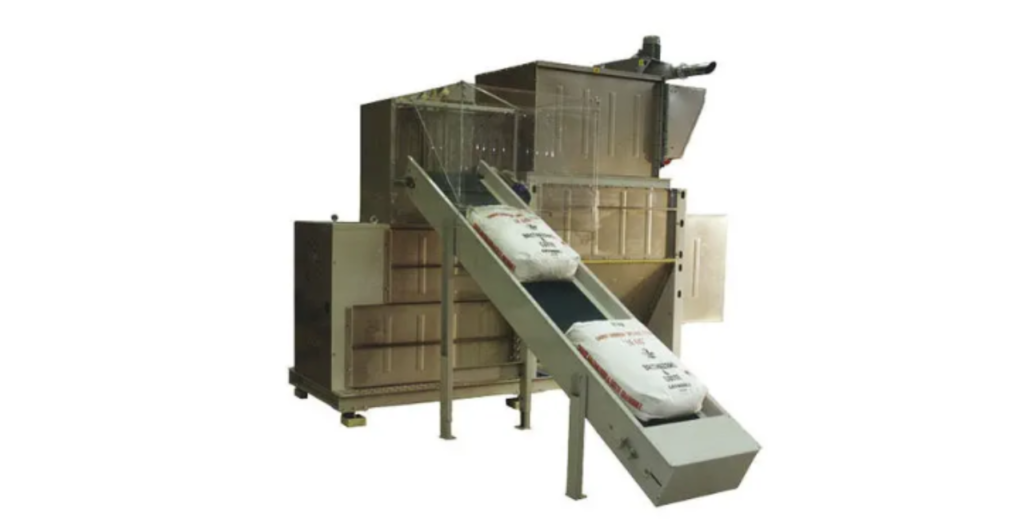
| Advantages: |
| Automation: These machines automate the bag emptying process, reducing the need for manual labor and increasing overall process efficiency. |
| Safety: By minimizing manual handling of heavy bags and controlling dust emissions, they improve workplace safety. |
| Efficiency: Automatic Bag Emptying Machines can process bags quickly and consistently, reducing unloading time and improving productivity. |
| Dust Control: Dust collection systems prevent the release of airborne particles, maintaining a clean and safe working environment. |
| Versatility: They can handle a wide range of bulk materials, making them suitable for various industries. |
| Disadvantages: |
| Initial Investment: The purchase and installation of Automatic Bag Emptying Machines can involve significant upfront costs. |
| Maintenance: Regular maintenance is required to ensure the safe and efficient operation of these systems. |
| Space Requirements: They may require dedicated space in the facility for operation and storage. |
| Complexity: Some systems may be complex to operate and require trained personnel. |
| Applications: |
| Automatic Bag Emptying Machines find applications in various industries, including: |
| Food Industry: For handling ingredients like flour, sugar, and spices. |
| Pharmaceuticals: In the handling of pharmaceutical powders and ingredients. |
| Chemical Industry: For unloading bulk chemicals and powders. |
| Agriculture: In the handling of fertilizers, seeds, and agricultural bulk materials. |
| Construction: For handling cement, sand, and construction materials. |
| Mining and Minerals: In the handling of minerals, ores, and aggregates. |
| Materials of Construction (MOC): |
| The choice of materials for Automatic Bag Emptying Machines depends on factors such as the type of material being handled, hygiene requirements, and corrosion resistance. Common materials of construction include: |
| Stainless Steel: Suitable for industries requiring corrosion resistance and hygiene, such as food and pharmaceuticals. |
| Carbon Steel: Commonly used in non-food industrial applications where corrosion resistance is not a primary concern. |
| Plastics or Coatings: Used for certain components to prevent material contamination and corrosion. |
| Summary: |
| Automatic Bag Emptying Machines are essential industrial equipment used to efficiently and safely empty bulk bags containing powdered or granulated materials. These machines offer advantages such as automation, improved safety, efficiency, and dust control. However, they come with considerations like initial cost, maintenance requirements, and space utilization. The choice of equipment and materials of construction depends on specific industry requirements and applications, ensuring the safe and efficient handling of bulk bags. |
E. Pneumatic Bulker Unloading and Storage System
| A Pneumatic Bulker Unloading and Storage System is an industrial system designed for the efficient unloading and storage of bulk materials, typically in powdered or granulated form, from bulkers or road tankers. This system utilizes pneumatic (air pressure) principles to convey materials from the delivery vehicle to storage silos or processing equipment. Here’s a detailed overview of the Pneumatic Bulker Unloading and Storage System, including its working principles, advantages, disadvantages, applications, materials of construction (MOC), and a summary: |
| Working Principles: |
| The working principles of a Pneumatic Bulker Unloading and Storage System involve the following steps: |
| Bulk Material Delivery: A bulk material delivery vehicle, such as a bulker or road tanker, arrives at the unloading station. |
| Unloading: The bulk material is unloaded from the delivery vehicle into a reception hopper through a specially designed discharge nozzle or pipe. |
| Pneumatic Conveying: A pneumatic conveying system, which includes blowers or compressors, conveys the material from the reception hopper to storage silos or other designated containers using air pressure. |
| Material Separation: As the material is conveyed through the pipeline, air filters or separators remove entrained dust and impurities, ensuring clean material transfer. |
| Storage: The conveyed material is directed into storage silos or containers, where it can be stored until needed for further processing or distribution. |
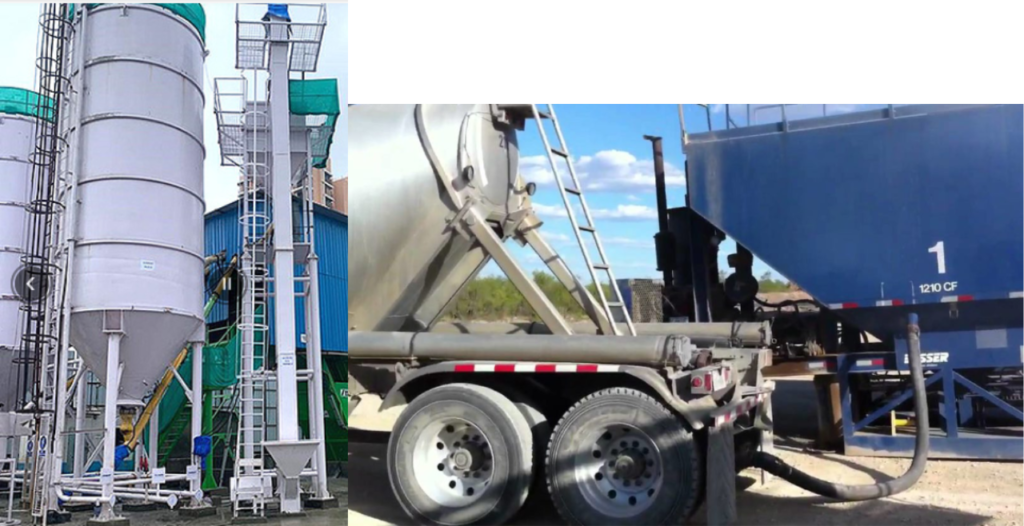
| Advantages: |
| Efficiency: Pneumatic conveying systems offer rapid and efficient unloading and transfer of bulk materials, reducing unloading time. |
| Clean Transfer: These systems are effective at preventing material contamination and minimizing dust emissions. |
| Versatility: Pneumatic bulker unloading systems can handle a wide range of bulk materials, including powders, granules, and pellets. |
| Reduced Manual Labor: Automation reduces the need for manual labor in material unloading and transfer operations. |
| Flexibility: The system can be designed to accommodate various delivery vehicles and multiple storage silos. |
| Disadvantages: |
| Initial Cost: The purchase, installation, and integration of a pneumatic bulker unloading system can involve significant upfront costs. |
| Maintenance: Regular maintenance is required to ensure the safe and efficient operation of the system, including filter cleaning or replacement. |
| Energy Consumption: Pneumatic systems consume energy to generate air pressure, leading to operational costs. |
| Space Requirements: These systems require dedicated space for equipment installation and pipeline routing. |
| Applications: |
| Pneumatic Bulker Unloading and Storage Systems are used in various industries and applications, including: |
| Chemical Industry: For unloading and transferring bulk chemicals and powders. |
| Food Industry: In the handling of food ingredients like flour, sugar, and spices. |
| Pharmaceuticals: For unloading and conveying pharmaceutical powders and ingredients. |
| Agriculture: In the handling of fertilizers, grains, and seeds. |
| Cement and Construction: For handling cement, sand, and construction materials. |
| Minerals and Mining: In the unloading and transfer of minerals, ores, and aggregates. |
| Materials of Construction (MOC): |
| The choice of materials for Pneumatic Bulker Unloading and Storage Systems depends on factors such as the type of material being handled and environmental conditions. Common materials of construction include: |
| Stainless Steel: Suitable for industries requiring corrosion resistance and hygiene, such as food and pharmaceuticals. |
| Carbon Steel: Commonly used in non-food industrial applications where corrosion resistance is not a primary concern. |
| Plastics or Coatings: Used for certain components to prevent material contamination and corrosion. |
| Summary: |
| A Pneumatic Bulker Unloading and Storage System is an industrial solution for efficiently unloading bulk materials from delivery vehicles and conveying them to storage silos or processing equipment using pneumatic principles. These systems offer advantages such as efficiency, clean transfer, versatility, and reduced manual labor. However, they come with considerations like initial cost, maintenance requirements, energy consumption, and space utilization. The choice of equipment and materials of construction depends on specific industry requirements and applications, ensuring the efficient and reliable handling of bulk materials. |
F. Pneumatic container loading systems
| A Pneumatic Container Loading System is an industrial system designed for efficiently loading bulk materials, typically in powdered or granulated form, into shipping containers, such as ISO containers or bulk bags. This system utilizes pneumatic (air pressure) principles to convey materials from storage silos or processing equipment into containers. Here’s a detailed overview of the Pneumatic Container Loading System, including its working principles, advantages, disadvantages, applications, materials of construction (MOC), and a summary: |
| Working Principles: |
| The working principles of a Pneumatic Container Loading System involve the following steps: |
| Material Transfer: Bulk materials are conveyed from storage silos or processing equipment into a reception hopper through a pneumatic conveying system using air pressure. |
| Material Distribution: The conveyed material is distributed into the container through specially designed discharge nozzles or pipes. |
| Container Filling: The container is filled with the bulk material, typically under a controlled flow rate to prevent overfilling or excessive dust generation. |
| Monitoring: The system often includes sensors and controls to monitor the level of material in the container and ensure accurate filling. |
| Dust Control: Dust collection systems or filters are often employed to capture airborne dust particles during the loading process, maintaining a clean and safe working environment. |
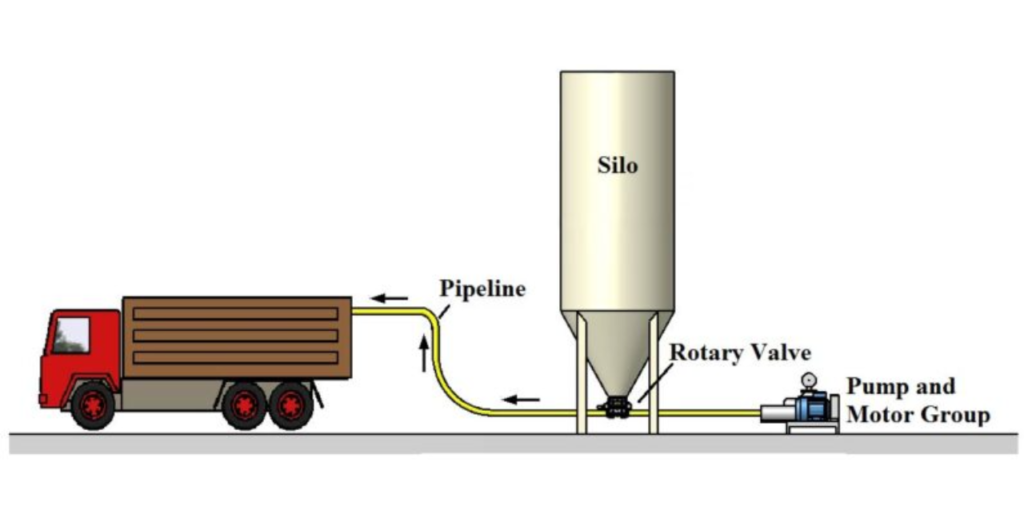
| Advantages: |
| Efficiency: Pneumatic container loading systems offer rapid and efficient loading of bulk materials into containers, reducing loading time. |
| Clean Loading: These systems effectively control dust emissions, ensuring clean and safe loading operations. |
| Accuracy: The system can be designed to provide precise control over the filling process, preventing overfilling or material spillage. |
| Versatility: Pneumatic systems can handle a wide range of bulk materials, including powders, granules, and pellets. |
| Reduced Manual Labor: Automation reduces the need for manual labor in the container loading process. |
| Disadvantages: |
| Initial Cost: The purchase, installation, and integration of a pneumatic container loading system can involve significant upfront costs. |
| Maintenance: Regular maintenance is required to ensure the safe and efficient operation of the system, including filter cleaning or replacement. |
| Energy Consumption: Pneumatic systems consume energy to generate air pressure, leading to operational costs. |
| Space Requirements: These systems require dedicated space for equipment installation and container loading operations. |
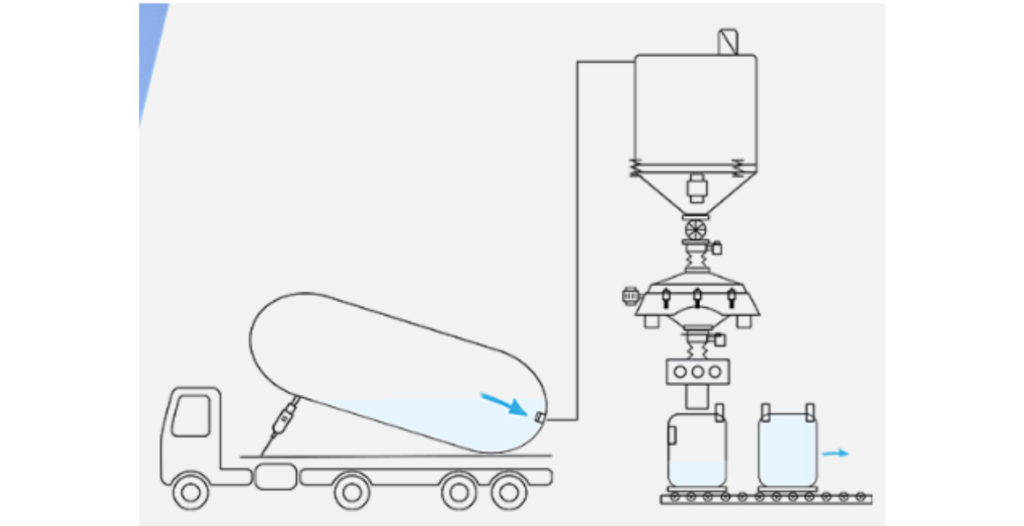
| Applications: |
| Pneumatic Container Loading Systems are used in various industries and applications, including: |
| Chemical Industry: For loading and transporting bulk chemicals and powders into containers for shipping. |
| Food Industry: In the loading of food ingredients like flour, sugar, and grains into containers for distribution. |
| Pharmaceuticals: For loading and transporting pharmaceutical powders and ingredients into containers for shipment. |
| Agriculture: In the loading of fertilizers, seeds, and agricultural bulk materials into bulk bags or containers. |
| Cement and Construction: For loading cement, sand, and construction materials into containers for construction sites. |
| Minerals and Mining: In the loading and transport of minerals, ores, and aggregates into shipping containers. |
| Materials of Construction (MOC): |
| The choice of materials for Pneumatic Container Loading Systems depends on factors such as the type of material being handled and environmental conditions. Common materials of construction include: |
| Stainless Steel: Suitable for industries requiring corrosion resistance and hygiene, such as food and pharmaceuticals. |
| Carbon Steel: Commonly used in non-food industrial applications where corrosion resistance is not a primary concern. |
| Plastics or Coatings: Used for certain components to prevent material contamination and corrosion. |
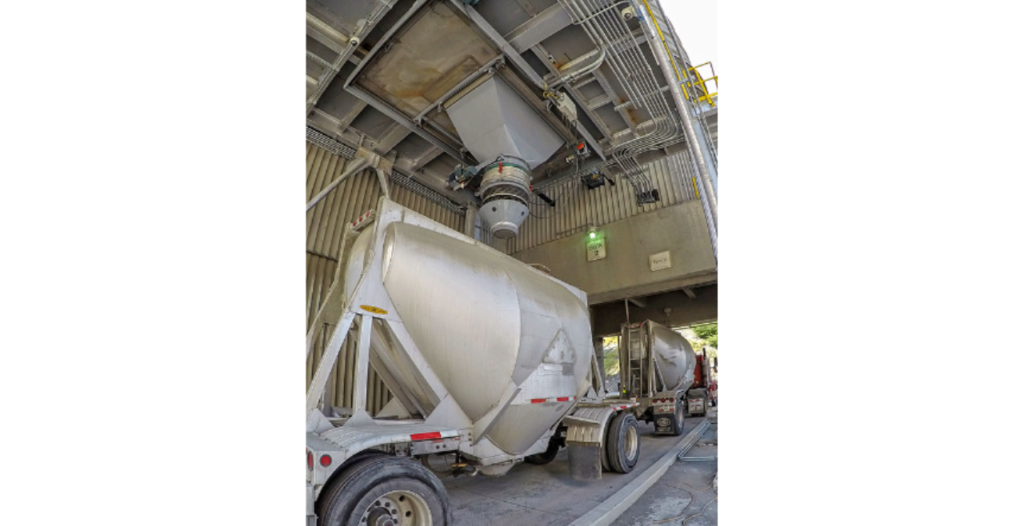
Summary:
A Pneumatic Container Loading System is an industrial solution for efficiently loading bulk materials into shipping containers using pneumatic principles.
These systems offer advantages such as efficiency, clean loading, accuracy, versatility, and reduced manual labor.
However, they come with considerations like initial cost, maintenance requirements, energy consumption, and space utilization.
The choice of equipment and materials of construction depends on specific industry requirements and applications, ensuring the efficient and reliable loading of bulk materials into containers.


 Sales & Marketing:
Sales & Marketing:  Service Supports:
Service Supports:  Website:
Website: 